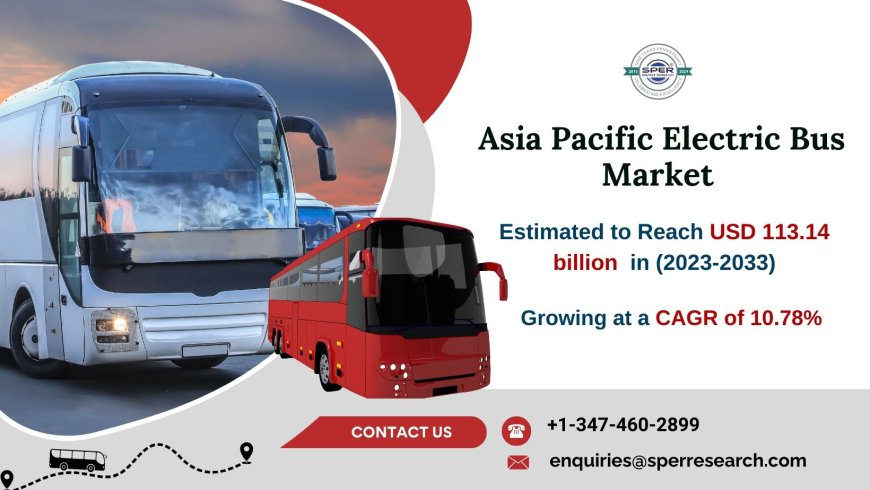Asia Pacific Electric Bus Market is expected to surge at a CAGR of 10.78%, reaching USD 113.14 billion by 2033: SPER Market Research.
APAC Electric Bus Market Share, Key Players, Growth Drivers, Business Challenges, and Opportunities Till 2033

The battery electric bus is a vehicle that runs on electricity. In this sort of vehicle, the electric motor is powered by both the onboard battery and external power sources. Charging electric buses is more complicated than refuelling a diesel vehicle. The charging process must be continuously watched and attended to in order to be optimised. It is commonly used in public transportation. In contrast, an electric bus is charged at a power station by connecting to an electric grid. The bus's battery system stores electricity to power the electric engine. These modes of transportation require less maintenance than fuel-powered buses since their engines contain fewer components than internal combustion engines.
According to SPER Market Research, ‘Asia Pacific Electric Bus Market Size- By Vehicle Type, By Power Source Type, By Consumer - Regional Outlook, Competitive Strategies and Segment Forecast to 2033’ states that the Asia Pacific Electric Bus Market is estimated to reach USD 113.14 billion by 2033 with a CAGR of 10.78%.
Drivers: Urbanisation and environmental concerns are a couple of the key reasons driving the Asia-Pacific electric bus market. Urbanisation and population growth are contributing to elevated levels of traffic congestion and pollution. Consequently, contemporary societies are exploring eco-friendly modes of transportation to mitigate these issues. Green urban mobility plans incorporate the use of electricity as a power source for buses, as it is considered environmentally benign due to its minimal impact on the environment. The use of electric buses is expanding due to new trends in major cities, such as the establishment of low emission zones and stringent emission regulations.
Restraints: The primary issue with electric buses is that, even with government assistance, their high initial cost makes them expensive to purchase. The process of adopting electric buses and purchasing the necessary recharging equipment is capital-intensive. The transit authorities in many rising economies, like Vietnam and Indonesia, have not been able to obtain the necessary money for 2023 and 2024. The expense of improved battery technology remains a financial barrier, but one that is rapidly decreasing. There are initiatives to lessen the burden of the costs on local governments and operators, but they have not yet been fully implemented. These initiatives include public-private partnerships and international funding.
Request For Free Sample Report @ https://www.sperresearch.com/report-store/asia-pacific-electric-bus-market.aspx?sample=1
The Asia Pacific Electric Bus market had a significant drop during the COVID-19 pandemic due to industrial shutdowns, lockdowns, and trade restrictions. Furthermore, the decline in vehicle production, restrictions on public transportation, and a labour shortage all had a substantial impact on the market. Automotive manufacturers have resumed operations in nations with a low number of COVID-19 instances, and the market is expected to rebound during the projected period. Furthermore, manufacturers are putting in place contingency measures to alleviate future business uncertainty and maintain continuity with clients in important sectors of the vehicle industry.
Key Players:
China is currently in the forefront of the adoption of electric buses thanks to sensible government regulations and sufficient funding for the industry. By employing electric buses, which are common in big cities, the government is focussing on reducing carbon emissions and improving the quality of the air in urban areas. Major players in the market are Anhui Ankai Automobile Industries Co. Limited, Ashok Leyland Limited, BYD Auto Co. Limited, King Long United Automotive Co. Limited, and Others.
Asia Pacific Electric Bus Market Segmentation:
By Vehicle Type: Based on the Vehicle Type, Asia Pacific Electric Bus Market is segmented as; Battery Electric Bus, Plug-in Hybrid Bus.
By Power Source Type: Based on the Power Source Type, Asia Pacific Electric Bus Market is segmented as; DC/AC Inverter, DC/DC Converter, DC/DC Boost Converter, E-Motor, AC/DC Charger, Motor Controller.
By Consumer: Based on the Consumer, Asia Pacific Electric Bus Market is segmented as; Government, Fleet Operators.
By Region: This report also provides the data for key regional segments of China, India, Japan, South Korea, Rest of South Africa.
This study also encompasses various drivers and restraining factors of this market for the forecast period. Various growth opportunities are also discussed in the report.
For More Information, refer to below link:-
Asia Pacific Electric Bus Market Outlook
Related Reports:
Follow Us –
LinkedIn | Instagram | Facebook | Twitter
Contact Us:
Sara Lopes, Business Consultant – U.S.A.
SPER Market Research
+1-347-460-2899
